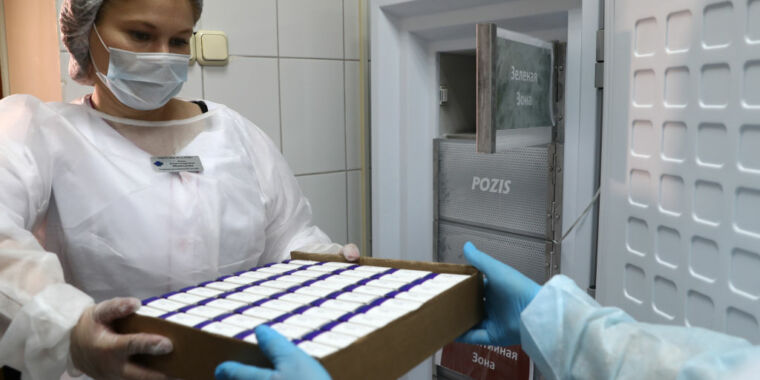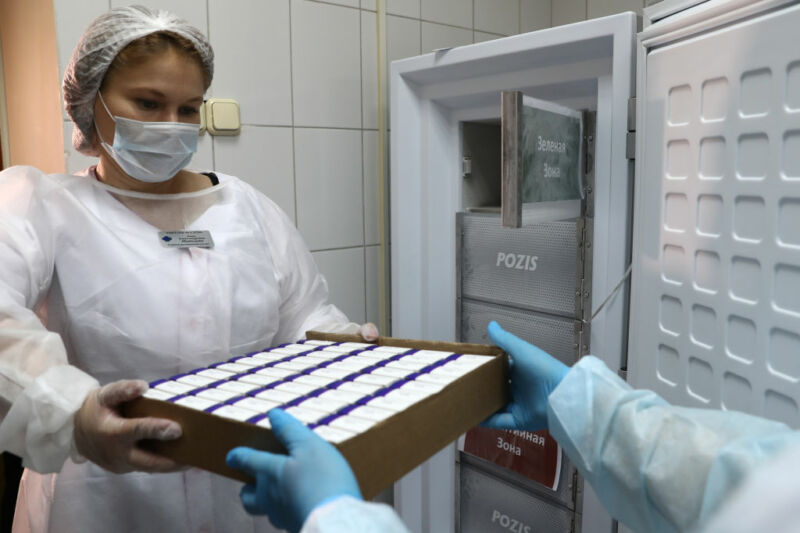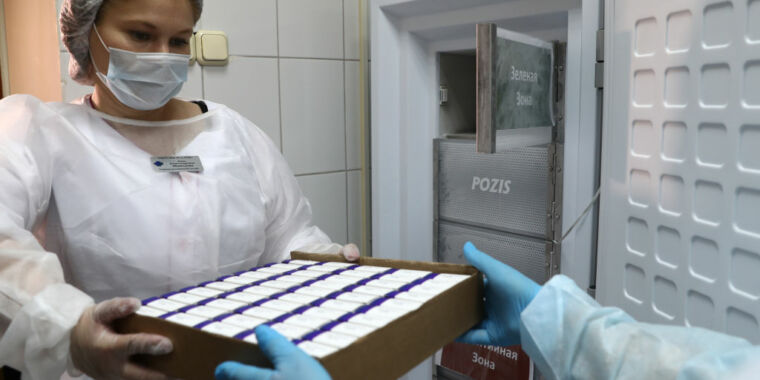
From Russia with adenovirus —
Most of the results are fairly expected, but there are some interesting details.

Enlarge / MOSCOW, RUSSIA – SEPTEMBER 4, 2020: Medical staff with newly delivered boxes containing COVID-19 vaccine in a cold room at No2 Outpatient Clinic in southern Moscow.
Russia has been one of the countries hit hard by the COVID-19 pandemic. But its response to that has been a bit… unusual. As many other countries have, Russia worked to develop its own vaccine. But while that development was still in progress, it announced that it wasn’t going to wait for detailed safety data, instead rolling the vaccine out to millions. Shortly afterwards, it became clear that the country was actually going to run a standard phase 3 clinical trial, albeit a large one, involving 40,000 people.
It was hard to judge whether any of this was reasonable, because few details about the vaccine itself were available. But that changed somewhat on Friday, as the people who developed the vaccine published results from the initial clinical trials. And so far, it seems to be about as effective as some of the other vaccine candidates that have been made it past initial trials.
Two viruses better than one?
As our earlier coverage mentioned, the vaccine is composed of two different engineered viruses. These contain the backbone of an innocuous virus, called an adenovirus, engineered to include the gene that encodes the major surface protein from the SARS-CoV-2 virus. This protein, called Spike, is what the coronavirus uses to latch on to and enter cells. The use of adenovirus allows the immune system to learn to recognize the Spike protein while the body only experiences a harmless adenovirus infection.
The issue with this approach is that lots of people have already encountered adenoviruses, and so may mount a robust immune response to it. This can lead to side effects that resemble the body’s normal response to a viral infection. (This was seen in tests of an adenovirus-based vaccine developed in China.) But it can also limit the immune response to the Spike protein, as the immune system focuses on the parts of the engineered virus that are familiar.
To test the vaccine, the researchers enrolled two groups of 38 people. The first group simply received a single injection of an adenovirus engineered to produce the Spike protein. The second group received the same initial injection, but it was followed up by a booster that used a different strain of adenovirus engineered with Spike.
The idea behind using two different engineered viruses is that, even if the immune system reacts to the adenovirus used in the first injection, it won’t be recently primed to attack the one used in the booster. Ideally, this should get the immune system to focus on the one thing that’s identical between these two viruses: the Spike protein.
Side effects and antibodies
As expected, many of those who received the vaccine, either with or without the booster, had side effects that resembled those you’d get from a viral infection. These included fever, headaches, general weakness, and muscle and joint pain. Beyond that, the only side effect noted was pain at the site of injection. None of these were rated as severe, and all of the participants in the vaccine-plus-booster group were able to go on and receive the booster.
Among those who had received a single shot, about 85 percent had developed SARS-CoV-2 specific antibodies two weeks after. By three weeks after, everyone had antibodies against the virus. Similar numbers were seen in the shot-plus-booster group, although the booster increased the levels of antibodies.
The researchers also looked for the presence of neutralizing antibodies, which bind to the Spike protein in a way that keeps it from interacting with and/or entering cells. These antibodies are often considered to be essential for defending against a viral infection, though the degree to which that’s true for SARS-CoV-2 has yet to be determined. Here, the use of a booster injection made a big difference. Without it, fewer than two-thirds of the participants generated neutralizing antibodies. With the booster, everyone did.
Another potential advantage of using a virus to deliver the Spike protein is that it engages all the normal features of the immune response—both antibody-producing B cells and the T cells that recognize infected cells. The researchers confirmed that the vaccination activated a T cell response in the participants, which may lead to a more robust immunity. And they found that many of these T cells responded to the Spike protein, rather than the adenovirus.
Works on ice
One of the nicer results reported here is that, despite requiring an intact virus to work, the vaccine worked after it had been frozen (though its effectiveness wasn’t compared to an unfrozen vaccine). In fact, the researchers were able to generate an immune response that was only slightly reduced using a vaccine that had been freeze dried and then re-dissolved in water. The researchers indicate that most of the vaccine will be administered from frozen stocks, but the freeze-dried version will be used for communities that aren’t very accessible, of which Russia has a number.
Overall, this is about what you’d want to see before moving on to larger trials—no major side effects paired with the production of an immune response that includes neutralizing antibodies. But the larger trials will be essential for a couple of reasons. One is that we need to know if there are rare but severe side effects, which might only become apparent in a larger population. And the second is that we need to know if the formation of neutralizing antibodies is actually protective—something that can only be established by giving the vaccine to a large enough population that some will inevitably be exposed to SARS-CoV-2.
This isn’t the only adenovirus-based vaccine that’s in development, and a number of them are already moving into large-scale trials. If any are successful, it’s likely to mean good news for the others that aren’t as far along. And if not, we’ll have to wait for one of the other technologies to make it through a trial.
The Lancet, 2020. DOI: 10.1016/S0140-6736(20)31866-3 (About DOIs).









